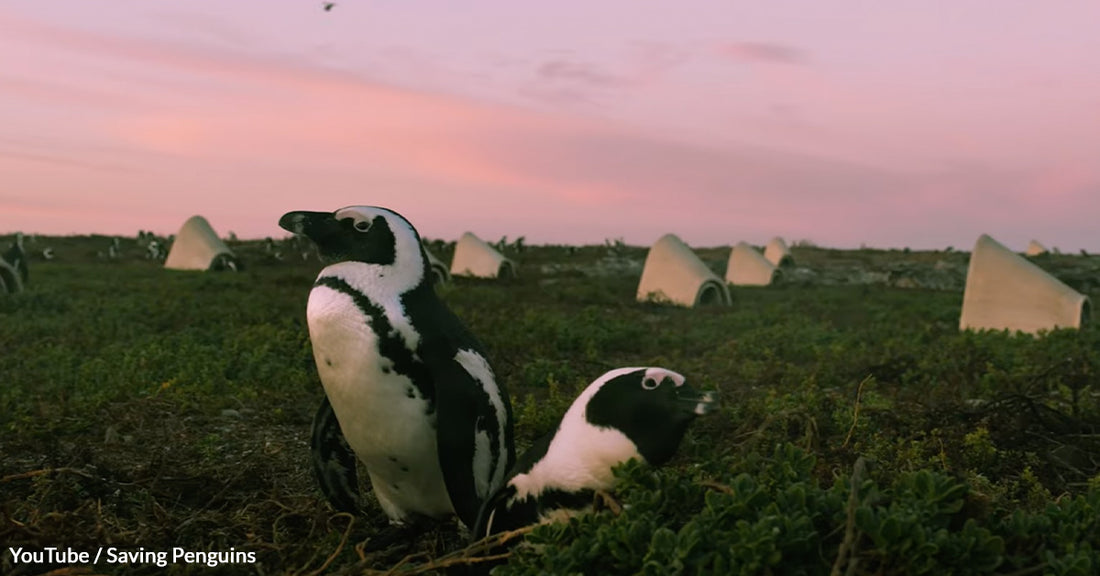7th Annual Holiday Toy & Book Event Help make the holidays brighter this year!
Artificial Nests Offer African Penguins a Last Hope as Populations Dwindle
Matthew Russell
African penguins, one of the world’s most endangered seabird species, are finally catching a break. After decades of population decline, conservationists are making significant strides in bolstering penguin breeding with a surprising tool: artificial nests.
These nests, designed to mimic natural burrows, have shown remarkable success in helping penguins raise their chicks in safer, cooler environments across South Africa’s coastal colonies. Yet, the solution is far from simple, as recent studies highlight how different penguin colonies require tailored designs to maximize breeding success.

The Decline of African Penguins
Once numbering in the millions, the African penguin population has suffered a staggering 90% decline in the past 70 years, The Washington Post reports. Today, fewer than 10,000 breeding pairs remain, leaving the species at high risk of extinction. The causes of their decline are numerous: overfishing of key food sources like sardines and anchovies, habitat loss, and pollution all play a part. Additionally, a deadly avian influenza virus has ravaged bird populations, including African penguins. Without intervention, experts fear these iconic seabirds may disappear from the wild forever.
Conservationists have been scrambling to find ways to protect penguin nesting habitats. Historically, African penguins dug burrows in accumulated guano, but much of that was harvested in the 19th and 20th centuries, leaving the birds without protection from the sun and predators, Earth Island Journal reports. This forced the penguins to build open nests, leaving their eggs and chicks vulnerable to extreme heat and predation. Recognizing this problem, researchers have turned to artificial nests as a way to offer a safer alternative.

Artificial Nests Offer Hope
A new study led by South African and British researchers and published in the British Ecological Society’s journal, Ecological Solutions and Evidence, provides compelling evidence that artificial nests can significantly improve the breeding success of African penguins. The researchers monitored eight of South Africa’s largest penguin colonies over a 12-year period and found that artificial nests boosted breeding success by an impressive 16.5% compared to natural nests.
But the study also revealed that no single design works best across all colonies. According to Professor Lorien Pichegru from Nelson Mandela University, who led the research, different colonies face unique environmental challenges that require distinct nest designs. For example, the newly designed double-layered ceramic nests worked well in sunny colonies with little vegetation, while simpler wooden boxes performed better in shaded, predator-free environments.
“The most effective designs of artificial nests were colony-specific,” Pichegru explained, “with different colonies facing different threats.” At Boulders Beach, for instance, ceramic nests with slanted roofs and ventilation gaps were critical in keeping the nests cool enough for penguins to breed safely. In contrast, at Bird Island, which lacks vegetation, the nests needed to provide better airflow to avoid overheating the eggs.

Tailored Conservation Efforts
The African Penguin Nest Project, a collaborative effort between the Dyer Island Conservation Trust, Dallas Zoo, and other organizations, has been instrumental in deploying these artificial nests. Over 1,500 nests have already been installed across several penguin colonies, including on windswept Bird Island. According to CNN, the nests have seen near-universal acceptance by the penguins, with 99% of the artificial nests being occupied by penguin families.
Kevin Graham, coordinator of the project, emphasized how important it is to create the right environment inside the nests. “Getting the right temperature and humidity inside the nest was the hardest and most important part,” he said. The double-layered ceramic design provides natural air conditioning, keeping the nests at a safe temperature for the delicate penguin eggs. “Any higher than [38 to 39 degrees Celsius], and there’s a very real risk of the eggs dying,” Graham noted.

More Than Just Nests
While artificial nests are a promising start, conservationists agree that they are only part of the solution. African penguins still face a number of other existential threats, particularly the lack of food. Overfishing has drastically reduced the availability of sardines and anchovies, leaving penguins to travel farther and expend more energy to feed themselves and their chicks. Establishing fishing exclusion zones around penguin colonies, as advocated by Pichegru and other researchers, could provide a lifeline for the species.
“The main causes of the recent decline in African penguin numbers are poor food availability, oil spills, underwater noise pollution, and predation,” Pichegru told Earth.com. Conservationists stress that unless these broader environmental issues are addressed, artificial nests alone will not be enough to reverse the penguin’s decline.
Efforts are also underway to rehabilitate abandoned chicks, with teams collecting eggs and rearing them in controlled environments. But with the population already so low, these efforts need to be scaled up urgently to prevent the species from tipping into extinction.
A Future For Penguins
As conservationists deploy more artificial nests, they are hopeful that these efforts, combined with other strategies, will help stabilize the African penguin population. Pichegru and her team plan to continue refining the nest designs, studying how different materials and shapes can improve breeding success under different conditions.
The African Penguin Nest Project aims to install another 4,500 artificial nests in the coming years, expanding into Namibia, the only other country with African penguin colonies. But the success of these efforts will depend on whether governments and conservation groups can also address food shortages and other environmental challenges.
Artificial nests offer a beacon of hope for these beleaguered seabirds, but the work is far from over. Conservationists remain focused on creating the right balance of strategies to ensure that future generations of African penguins can thrive.

